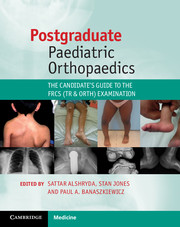Chapter 18 - MCQs and EMQs
Published online by Cambridge University Press: 05 August 2014
Summary
Children’s Orthopaedics multiple-choice questions
Part 1 of the FRCS (Tr & Orth) is the written part of the exam and consists of two papers. The first paper is sat in the morning while the second paper takes place in the afternoon. The Joint Committee on Intercollegiate Examinations endeavours to provide a minimum of 30 minutes between each paper.
It is considered the easiest part of the exam to pass, the clinicals and vivas being the difficult hurdles. This can lead to a false sense of security and some candidates may not apply themselves in their reading preparation as much as needed. The other issue is that candidates are not expected to fail this section, and this may increase expectations and pressures on candidates. The UK In-Training exam acts as a dress rehearsal and should be completed yearly by orthopaedic trainees. Your score should improve yearly and ideally peak the year before you sit the real exam. From 2013, the pass mark for the Part 1 exam has been increased by the Examination Board. This was unpredicted and means that candidates have to ‘up’ their exam preparation to avoid falling at this hurdle.
- Type
- Chapter
- Information
- Postgraduate Paediatric OrthopaedicsThe Candidate's Guide to the FRCS (Tr and Orth) Examination, pp. 263 - 277Publisher: Cambridge University PressPrint publication year: 2014



